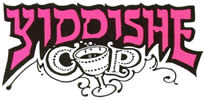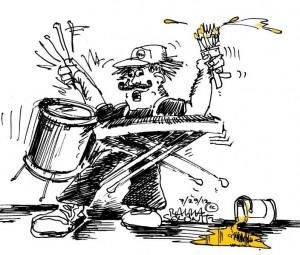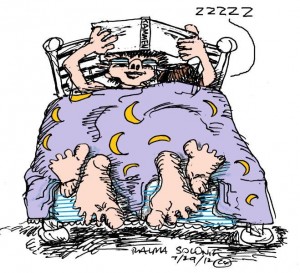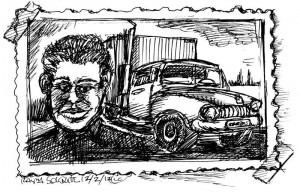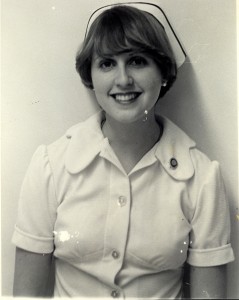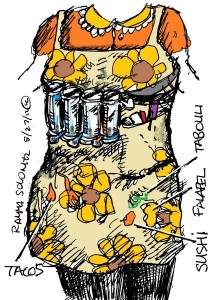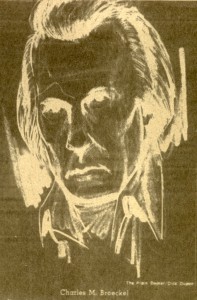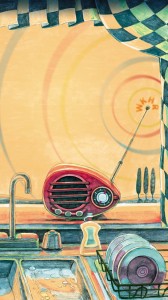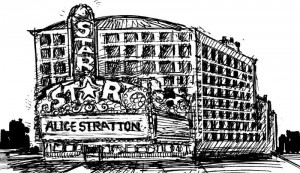Category — Family History, Not Boring
MISSISSIPPI BUBBE AND
THE XYLOPHONIST
I look for musical yikhes (lineage/pedigree) wherever I can find it. My grandmother played piano at a white Baptist church in Yazoo City, Mississippi. Not bad.
This Mississippi bubbe — Ida Kassoff Zalk — had a brother, Earl Kassoff, in Cleveland. Earl was a drummer, xylophonist and house painter. He went by the stage name Earl Castle, and led bands in the 1930s and 1940s.
In the 1990s — when I first began looking for musical yikhes — I couldn’t find much info on Earl. I talked to a couple relatives. Earl didn’t leave behind sheet music or tune books. He died in 1969.
At a Yiddishe Cup gig, an elderly musician schmoozed with me. I asked him if he knew Earl Kassoff. Yes, he remembered Earl. The schmoozer was Harold Finger, age 77. He had made a living playing clarinet and sax during the 1930s and 1940s.
I took my tape recorder to Harold’s apartment and interviewed him. He said there were “four or five bands that got the Jewish work.”
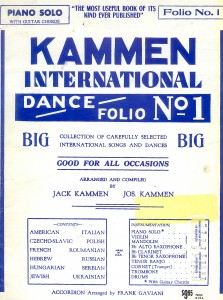 I asked, “What bands?” He didn’t remember the names. “What were the most popular Jewish tunes?” I said.
I asked, “What bands?” He didn’t remember the names. “What were the most popular Jewish tunes?” I said.
He said, “The songs from the Kammen Book. That was the big thing.”
The Kammen International Dance Folio, published in 1924, is still around. The Kammen book is to Jewish music what a sex manual is to sex. (Pianist Pete Sokolow makes this statement at most KlezKamp conventions.)
My Uncle Earl’s band did mostly “dance work” — American music, Harold said. Earl worked the downtown theaters, as well as the Golden Pheasant — a Chinese restaurant where Artie Shaw started.
Harold said he didn’t stick to the melody all the time. He did some “faking” (improvising). Now he played clarinet with a community orchestra. “I don’t do much jobbing anymore,” he said. (Jobbing is gigging.)
Harold died three years after the interview. I thought his kids might enjoy the interview tape, from 1992, so I called a Finger relative and left a message in the mid-1990s.
I didn’t hear back.
The relative should have called! Harold’s wife was on the tape, teasing Harold about how he loved his saxophone more than her. Harold said, “What? I quit playing music for you!”
—
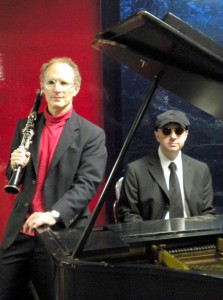 Michiganders, come to the Klezmer Guy show at The Ark, Ann Arbor, Feb. 15. 8 p.m. $20. Bert Stratton on clarinet and prose, Alan Douglass on piano and vocals, Gerald Ross on ukulele and Hawaiian lap steel guitar. Prose pieces will contain words such as “Ann Arbor,” “Michigan” and “Rudy Tomjanovich.”
Michiganders, come to the Klezmer Guy show at The Ark, Ann Arbor, Feb. 15. 8 p.m. $20. Bert Stratton on clarinet and prose, Alan Douglass on piano and vocals, Gerald Ross on ukulele and Hawaiian lap steel guitar. Prose pieces will contain words such as “Ann Arbor,” “Michigan” and “Rudy Tomjanovich.”
—
More on Mississippi Ida — my bubbe — later. Maybe not.
—
Yikhes update. Check out the latest from Jack Stratton’s band, Vulfpeck.
February 6, 2013 6 Comments
TRUCKIN’
My cousin David owned a GMC tractor-trailer, which he parked in the May Co. lot in University Heights. David may have been the only Jewish long-distance trucker in the Heights. Maybe the only long-distance trucker, period, in the Heights.
In 1975 David borrowed several thousand dollars from my father, Toby, for the truck. David had a contract with International Truck of Rock, Minnesota.
David moved to Pennsylvania and never repaid my dad.
In high school David had stolen hubcaps. He had been a Shaker Heights juvenile delinquent.
David even looked like James Dean. My cousin Danny once said, “David’s dad was the most handsome man you ever met.” David’s dad drifted around Cleveland, playing pool. David’s dad and mother divorced in the 1950s.
When David’s mother heard David hadn’t repaid my dad, she made payments, but she never fully repaid the loan.
My father’s attitude was “win some, lose some.” Toby believed in lending money to family. My dad had borrowed from his Uncle Itchy to buy his first house.
Last year I called David’s sister. This was a big deal; David and his sister were out of the cousins’ loop. David is now in his seventies and has had several heart attacks, his sister said. He is living in a hotel that his son runs in Florida.
No more truckin’.
No more David as family black sheep. Stolen hubcaps and an unpaid loan, is that the worst of it in my family? I think so.
Now, my wife has an estranged cousin who stole sterling silver . . . Stop.
—
“David” is a pseudonym.
—
SIDE B
FITBIT
I became bionic. My daughter, Lucy, gave me a pedometer.
I can count my daily steps. I can even monitor my sleep patterns, but that’s too much data — even for a guy like me who likes data.
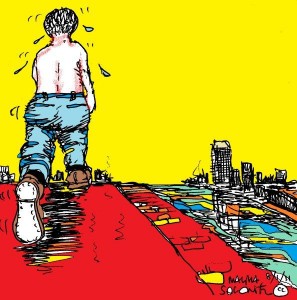 Brisk walking. If you do it, ipso facto, you’re a dork.
Brisk walking. If you do it, ipso facto, you’re a dork.
I gave up jogging last year. My right knee wasn’t into it anymore. I miss the “sweat” of jogging.
I walk.
Should I post my step count here? Dieters post their calories online. Bicyclists post their heart rates.
My step count today is _____. (Will post up at 11:59 p.m for maximum effect.)
Your count?
—
For a couple new illustrations by Ralph Solonitz, please scroll down to “KlezKamp 2012,” which went up last week.
—
Yiddishe Cup plays at First Night Akron on New Year’s Eve.
December 26, 2012 1 Comment
ALICE’S RESTAURANTS
Pre-kids, my wife, Alice, and I ate out a lot. We mostly went to dives. That was our hobby. Dives as low as Krisplee on East 82nd Street and Euclid Avenue, and Albino’s at West 44th Street and Lorain Avenue.
At home, Alice cooked a lot of tofu. That’s why we ate out a lot.
We don’t go out much now. I can’t stand the long waits, the so-s0 food, the noise. I’m my dad.
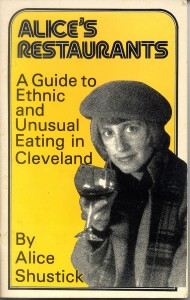 Alice published a restaurant guidebook, Alice’s Restaurants, in 1981. The book sold particularly well at the airport bookstore. Alice’s oddest recommendation was the cafeteria at Metro General Hospital. She liked the beef stroganoff and Viennese tort there. (Alice was a nursing student.)
Alice published a restaurant guidebook, Alice’s Restaurants, in 1981. The book sold particularly well at the airport bookstore. Alice’s oddest recommendation was the cafeteria at Metro General Hospital. She liked the beef stroganoff and Viennese tort there. (Alice was a nursing student.)
I liked Draeger’s, an ice cream place at Van Aken. I wasn’t into balanced meals.
Here are a couple recommendations from the book:
(Still around) Balaton, Corky & Lenny’s, Flat Iron Cafe, Mad Greek, Mamma Santa’s, Hot Dog Inn.
(Dead) Zosia’s, Gerome’s, Art’s Seafood, It’s It Deli, Vegetaria, Radu’s, Aurora, Draeger’s, El Charro.
When we had our first child, our eating out petered out. Alice wrote a baby book, but never published it. I can’t remember what the book was about, other than babies. Oh, it was The Bye, Bye Book — how to prepare your kid psychologically if you left town for a day or two.
Our kids — now grown — became foodies. Maybe we left them home too much. A lot of 20-somethings became foodies. A baby-boom friend described his grown kids’ religion as Foodism.
Alice — the original Foodist — sold street food. She never made a dime, but she made a name for herself. In the mid-1980s, Alice was the first to sell sushi rolls in Cleveland. This was at the Coventry Street Fair. Few locals knew what sushi was. Alice made vegetable rolls. She grossed well, but her expenses were high. She paid a Korean-American friend, Mike, to help. Mike lent an air of authenticity — not that he knew anything about sushi.
Alice did tabouli at the East 115th Street Fair. Tabouli was a loser. Why? It wasn’t that good. And a Cadillac with musicians playing in the trunk — next to Alice’s booth — was a lot more entertaining.
Alice sold falafel at the Coventry fair. She called that operation Queen Alice’s Falafel. We ate a lot of falafel because she was always tweaking the recipe. She did falafels for a couple years.
Alice is talking tacos lately. Our son Teddy is talking pad Thai.
Foodists.
—-
SIDE B
THE JEW OF HOME DEPOT
Carl Goldstein, a landlord friend of mine, wants to be a docent at Home Depot when he retires. He goes to Home Depot at least twice a day, six days a week. That’s more than 600 Home Depots visits per year. Carl owns and manages double houses on the East Side of Cleveland.
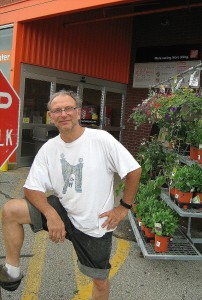
Carl Goldstein, 2011
He said, “Home Depot saved my life. Before they came to town, I used to go out to Builders Square on Wilson Mills. That was the ruination of my life. After Builders Square, I would take the freeway to DIY on Chagrin, and then to Seitz-Agin [hardware] on Lee. And I still wouldn’t have everything I needed!”
Carl worked at a plumbing supply store for seven years; he sold hot water tanks, boilers, Flushmates and plumbers dope. Carl’s father was a plumber in Flint, Michigan. Carl has a collection of Corky toilet flappers and other odds and ends in his truck. He gave me a Niagara water-saving shower head. ($5.13 from Woodhill Supply. Too specialized for Home Depot.)
I  bought more Niagaras. I have about fifty now. I switch shower heads when tenants move out. (Bad business to switch shower heads on current tenants.)
bought more Niagaras. I have about fifty now. I switch shower heads when tenants move out. (Bad business to switch shower heads on current tenants.)
Carl wants Home Depot to hold a storewide scavenger hunt. The first contestant through the Home Depot check-out line with all the correct items wins. “I’m a shoo-in,” Carl said. “Second place would be Marc Apple.”
“Marc Apple?”
“He’s a Cleveland Heights contractor,” Carl said.
There are two Jews of Home Depot in Cleveland.
—-
Read Max Apple’s The Jew of Home Depot and Other Stories. (Max Apple is not related to Marc Apple.)
Next: The Jews of Home Depot (Atlanta): Bernie Marcus and Arthur Blank.
—
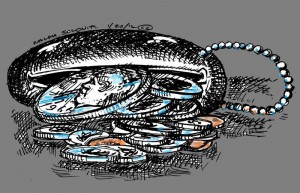 I wrote about Alice, hot weather and money at today’s CoolCleveland website.
I wrote about Alice, hot weather and money at today’s CoolCleveland website.
—
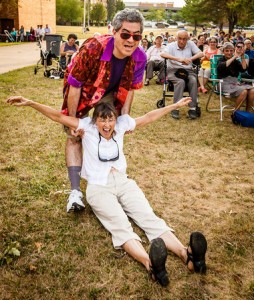 Alice and dance leader Daniel Ducoff on the front page of the Cleveland Heights Sun Press, 7/12/12. (Well-written article about Yiddishe Cup by Ed Wittenberg. Photo by Jim Olexa.)
Alice and dance leader Daniel Ducoff on the front page of the Cleveland Heights Sun Press, 7/12/12. (Well-written article about Yiddishe Cup by Ed Wittenberg. Photo by Jim Olexa.)
July 18, 2012 11 Comments
THE SILVER FOX / THE CREEP
Charlie Broeckel was the Silver Fox or The Creep. He went by both names. He was a burglar and hit-man in Collinwood –- a neighborhood in northeast Cleveland.
I’m not sure where Broeckel is now. Maybe he’s dead. Or maybe he’s in a safe house in Ada, Oklahoma. For a while he was “John Bradford” (federally protected) in the Pacific Northwest.
Broeckel and Phil Christopher — another Collinwood burglar — did a bank heist at Laguna Niguel, California, in 1972. It was supposedly the biggest bank burglary of all time. Charlie and Phil flew to California from Cleveland for the job. California didn’t have quality bank burglars back then, I guess. Collinwood did.
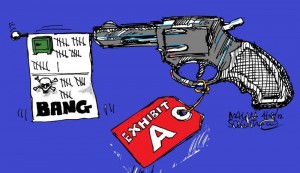 I saw Broeckel and Christopher at trials in Cleveland. They would periodically come in from their federal prison cells or witness protection program locations. One trial was for murder: Christopher and accomplices took a pimp, Arnie Prunella, out on a boat, shot him and drown him.
I saw Broeckel and Christopher at trials in Cleveland. They would periodically come in from their federal prison cells or witness protection program locations. One trial was for murder: Christopher and accomplices took a pimp, Arnie Prunella, out on a boat, shot him and drown him.
Collinwood was “think ethnic”-to-the-10th power. There were four distinct neighborhoods in Collinwood: Slovenian (St. Mary’s parish), Italian (Holy Redeemer), black (west of the E. 152nd Street, aka the DMZ) and Lithuanian (Our Lady of Perpetual Help). Broeckel’s ethnicity was indeterminate. Maybe German, maybe Slovenian. Christopher was Italian.
Broeckel and his fellow burglars stored nitroglycerin — used for blowing up safes — on a Lake Erie beach. In 1983 a Cleveland policeman operated a backhoe at the local beach, searching for old, very unstable nitro. Traffic cops kept reporters and passersby at a distance. Charlie was supposedly in bad health and wanted brownie points for helping the cops find old explosives.
The chief cop in the neighborhood — Capt. Ed Kovacic — had a warm spot for highly skilled crooks. These thieves would drill out safes and jump burglar alarms. They weren’t entirely stupid. Kovacic often said, “If there was a hall of fame for burglars and safecrackers, it would be in Collinwood.”
In 2006, Lyndhurst police chief Rick Porrello wrote a book, Superthief, about Christopher. Then Tommy Reid, a Hollywood entrepreneur, made a documentary movie –- also Superthief — which came out in March. The movie is mostly talking heads: old cops and old thieves sitting in living rooms, reminiscing about old days.
The documentary ran exclusively in theaters in Euclid and Lake County — where many former Collinwood residents moved to. There were three people in the Lakeshore Cinema. One elderly man, with a walker, said on his way out, “Phil is a thief!” His wife said, “I like Phil!”
Christopher, 66, is out of jail. He has spent nearly half his life in prison. What if Broeckel — the creep, the silver fox, the rat — comes out of hiding and puts Christopher back in prison?
Just like old times.
—
I was a police reporter in Collinwood for Sun Newspapers in the 1980s. (Last time I’m going to mention this factoid for a while. So please remember.)
—-
SIDE B
Here is the annual “inside baseball” post. Your name might be in here . . .
NAMING NAMES
We interrupt this blog to tell you this blog is three years old.
“I’ve read every word of your blog!” a musician told me.
Hooray for him. I wrote every word.
A blog reader said, “You found your subject — your father, Toby.”
No, you did. I’ve had Toby on the brain for decades.
A woman said, “I look forward to your posts every Wednesday morning . . . I don’t do comments.”
Here’s my comment: Nine-tenths of Klezmer Guy readers don’t do comments. They want to protect their animosity. Listen, you are not above comments; you are not paying for this; chip in the occasional enlightening, humorous or really stupid comment.
Several other readers claim to have read every word of the blog.
What was the first word?
Special thanks to our major donors (commenters). I could have done it without you, but it wouldn’t have been as much fun.
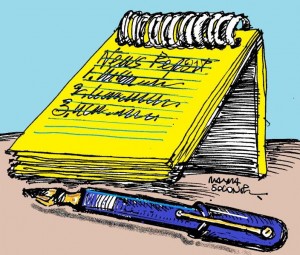 In no particular order, thanks to Marc Adler, Jessica Schreiber, Gerald Ross, Seth Marks, Ted, Adrianne Greenbaum, Bill Jones, Mark Schilling, Harvey Kugelman, Ellen, Susan Greene . . .
In no particular order, thanks to Marc Adler, Jessica Schreiber, Gerald Ross, Seth Marks, Ted, Adrianne Greenbaum, Bill Jones, Mark Schilling, Harvey Kugelman, Ellen, Susan Greene . . .
David, Margie, Irwin Weinberger, Jane Lassar, Zach Kurtz, Alice Stratton, Alan Douglass, Steve, Jack, Don Friedman, Kenny G, Steven Greenman . . .
Charlie B, Don Edwards, Garry Kanter, Jack V, Ari Davidow, Emilie, B Katz and Richard Grayson.
Get your name on this list next year by contributing at least $2,500 or writing comments.
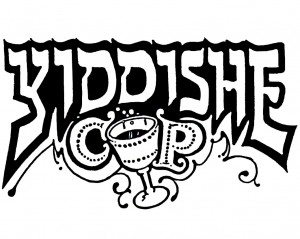 Special thanks to Ralph Solonitz, the blog’s illustrator. He adds a lot. I encourage him to throw in as many pics as possible. Works out well. Ralph had a Klezmer Guy illustration in The Forward recently.
Special thanks to Ralph Solonitz, the blog’s illustrator. He adds a lot. I encourage him to throw in as many pics as possible. Works out well. Ralph had a Klezmer Guy illustration in The Forward recently.
I met Ralph about 21 years ago when he designed Yiddishe Cup’s logo. That’s still your best logo, Ralph.
Sometimes I send my stories to the media before posting here. This past year Klezmer Guy articles were published throughout the planet: the International Herald Tribune, New York Times, City Journal, Ann Arbor Observer, Cleveland Plain Dealer, Jerusalem Post. Did I miss any continent? I’ve started to link to some of the newspaper articles. Please see the right side of this blog, under “Articles.” Also, check out “Categories” there. “Categories” is particularly useful if you want to read 68 posts in a row about real estate.
Google Analytics — a spy op — says there are Klezmer Guy readers in every state and many foreign countries. Ohio has the most Klezmer Guy readers, followed by New York, California, Michigan and Massachusetts. The top foreign countries are Canada, United Kingdom, Israel, Germany and Australia.
Google Analytics, for your information, zeroes in on readers by their hometowns, not their names. For instance, somebody in Chico, California, reads this blog.
The bell rings, round four.
—-
I wrote this op-ed, “The Impossible Dream,” for Mother’s Day for the Cleveland Plain Dealer (5/13/12). It’s about listening to the radio with my mother.
Illustration by Ted Crow, Plain Dealer
May 16, 2012 10 Comments
GOLF OR TAXES
Every January I spend a day filling out employer tax forms.
My favorite is the Federal Unemployment Tax Act (FUTA) form.
I did my first FUTA Form 940 in 1978, when my dad went to Florida for the winter. He and his high school buddies golfed in Boca Raton, and I filled out FUTAs in Cleveland.
Not bad. I like tax forms better than golf.
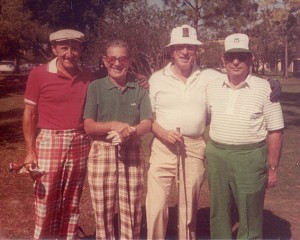
Toby Stratton (far L) w/ friends at Boca Lago CC, 1983
The treasurer of Ohio likes his W-2 reconciliations promptly. The Ohio Bureau of Employment Services also likes its money quickly. The Ohio Workers Compensation bureau has rachmones (pity) and bugs me only twice a year, not quarterly like everybody else.
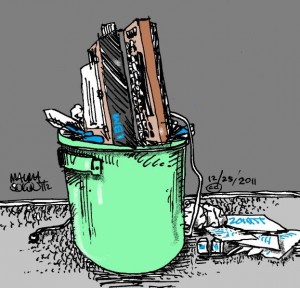 I used an IBM Selectric-style typewriter for tax forms until the machine died last year. The A key wouldn’t work. That was its main drawback.
I used an IBM Selectric-style typewriter for tax forms until the machine died last year. The A key wouldn’t work. That was its main drawback.
“ lbert
Str tton” didn’t cut it with the government. I threw out the typewriter and several boxes of Ko-Rec-Type.
Now I use IRS computer forms, except for my Yiddishe Cup 1099s, which I do by hand.
Last year I used blue ink on Yiddishe Cup’s 1099s.
The gobierno prefers black ink, I’ve learned. I’ll get with the program this year.
What are you in jail for?
Blue ink.
No thanks.
***
I wore a camping headlamp and crawled around the attic, culling old manila folders, making room for new files.
The old files weren’t read by anybody.
Why did I save all this stuff?
Because the government wanted me to.
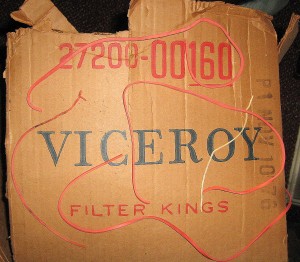 I got insulation flecks on my fleece jacket. It was freezing up there. And there were mouse droppings and desiccated rubber bands.
I got insulation flecks on my fleece jacket. It was freezing up there. And there were mouse droppings and desiccated rubber bands.
My dad used to recycle manila folders. For instance, he would reuse the file “1975 Plumbing” in 1981.
I threw out 30 pounds of paid invoices, checks and rent rolls. I do this every January.
Should I feel nostalgic?
I don’t.
—-
Here’s an op-ed, “From Soltzberg to Stratton,” from last week’s Jerusalem Post (Jan. 17).
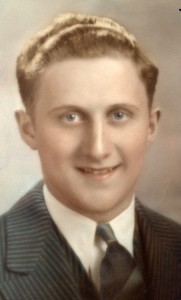
Theodore “Toby” Stratton (ne Soltzberg), 1938, age 21
January 25, 2012 10 Comments
THANK GOD I’M SLOVENIAN
The sign at the McDonald’s on Lake Shore Boulevard read: 30-minute time limit while consuming food. The manager must enforce these rules. Your cooperation is appreciated.
Several retired cops sat beneath the sign, drinking coffee all morning.
Ex-cop Bill Tofant said to me, “I used to work out every day at the YMCA. You know what that stands for? The Yiddishe Meat Cutters Union.”
I didn’t know that. (I was with retired cops because I was a police reporter in the 1980s.)
“I can still run a mile at 73 and hold my own in fisticuffs, and I can turn my head to see if traffic is coming,” Tofant said.
Tofant liked me — or put up with me — because my Great Uncle Itchy Seiger had owned a deli on Kinsman Road, which all the cops used to eat at. “Your uncle would throw his arms around me every time I came into the restaurant,” Tofant said. “I couldn’t spend a nickel there. They had corned beef, turkey, you name it, gherkin pickles.”
The cops at McDonald’s decided to rate pawnbrokers — most of whom were “good sharpYidls.”
I knew one of the Yidls: Larry Botnick of Euclid Loan at East 59th and Euclid. Larry had played tennis with my father. Larry got shot and killed in a stick-up. A couple streets over, there had been another stick-up . . .
“Three colored guys went in back of East 63rd and St. Clair,” said Bill Lonchar, an ex-cop. “One guy had a horse pistol yea long. It stuck out like a sore thumb. It was a military weapon.”
Re: the pawnbroker at East 79th and Hough . . . 1.) not shot at, and 2.) “not so good.” “He would buy a stove [gun] that was red hot and smile.”
The cops rated Italian. Not pawnbrokers. Burglars. Hardly worth talking about. “If you’re not Italian, you’re nobody. All that goddamn bullshit. All that Italian camaraderie bullshit.”
The Lithuanians were worth talking about. “The Lits will eat soup for twenty years, three times a day, and save their money, and all of a sudden they buy apartment buildings,” Lonchar said.
The Irish: dunderheads.
The blacks: no comment.
 The Slovenians: “Very respectable.” Top of the line. “There was a safecracker, Charlie Broeckel,” Lonchar said. “He went out to Laguna Niguel, California, and hit a bank there. Burned [spent] seven-mill worth of shit in negotiable papers. Charlie always found his way out. He might have been German, not Slovenian, actually. His mother held a very respectable job. She was beyond reproach, nothing like a stumblebum. The Broeckels lived at 8815 St. Clair.”
The Slovenians: “Very respectable.” Top of the line. “There was a safecracker, Charlie Broeckel,” Lonchar said. “He went out to Laguna Niguel, California, and hit a bank there. Burned [spent] seven-mill worth of shit in negotiable papers. Charlie always found his way out. He might have been German, not Slovenian, actually. His mother held a very respectable job. She was beyond reproach, nothing like a stumblebum. The Broeckels lived at 8815 St. Clair.”
Put up a plaque. Lonchar was Slovenian. [So were the district police commander, the ward councilman and the mayor, Voinovich. All lived within a mile of McDonald’s. (Voinovich was half Slovenian, half Serbian. Good enough.)]
—–
Footnote: “Thank God I’m Slovenian” was a popular bumper sticker in Cleveland in the 1980s. Cleveland has more Slovenian immigrants than any American city.
The top-selling ethnic bumper stickers in Cleveland were “Thank God I’m Polish” and “Thank God I’m Irish.” I know, I interviewed the bumper-sticker maker in Broadview Heights. Special-order: “Thank God I’m Transylvanian Saxon.” No market: “Thank God I’m Jewish.”
Check out this vid, Who’s Cheaper: Slovenians or Lithuanians?
January 4, 2012 1 Comment
THE BILLYS
My parents often name-dropped Billys, who I usually didn’t recognize.
The Billys were:
1.) Billy Rose. He put together the Aquacade show at the Great Lakes Exposition in 1936-7. The Aquacade was a theater-like pool. There was an orchestra and synchronized swimming. Johnny Weissmuller starred in it. Billy Rose took the show to the New York World’s Fair in 1939.
2.) Billy DeWolfe. A character actor. Billy De Wolfe occasionally ate at my Great Uncle Itchy’s restaurant, Seiger’s, on Kinsman Road. Was Billy De Wolfe really Billy D. Wolf, Billy The Wolf, or what?
3.) Billy Weinberger, a Short Vincent Street restaurateur (Kornman’s) who moved to Las Vegas in 1966 and took over Caesar’s Palace. My Uncle Al got discount hotel rates “from Billy” in Vegas. Billy was close with the Cleveland mobsters who started Vegas.
***
Did I ever name-drop Billys to my kids? I don’t think so. I can’t think of any Billys. My parents took all the Billys.
I did Garys: Gary Moore, Gary Powers and Gary Lewis.
—
Bonus: Whatever Happened to Putt Putt?, an original video:
October 19, 2011 5 Comments
HOLLYWOOD BOWLS US
My wife, Alice, was one of the many star-struck fans who drove to Rockside Road and I-77 in Cleveland to audition for The Avengers movie.
I asked Alice, “Did you get the part? Did you read anything?”
Not only did she not read, she did not even audition. The traffic was so horrendous at Rockside Road, she turned around. Thousands of people had shown up for the audition. The line of wannabes snaked at least a mile from the building, according to the Cleveland Plain Dealer.
There was another Hollywood movie, Fun Size, filmed a few weeks earlier, several blocks from our house in Cleveland Heights. That’s when Alice got star struck. Catering and make-up trucks were around our neighborhood.
I heard about it. I didn’t want to see the trucks. I have a bias against Hollywood.
Hollywood guys have too much fun. They should be making radiator valves, or PVC pipe fittings, like the rest of the world. Not blowing things up and eating from catering trucks.
My wife’s school gym (where she teaches elementary-school physical education) was turned into a vast make-up room for Fun Size. She said the school board got $500,000 for the rental.
I didn’t believe that. Alice’s source — the school janitor — told her the five-hundred grand figure.
Make that $50,000. I’d accept that. Better yet, $5,000. Who would pay half a million to rent a school building for a couple days? Hollywood is a funny ballpark, but not that funny.
Hollywood’s latest tax-abatement haven/heaven is Ohio. Used to be Michigan.
I would like to be in a movie, Alice. But I would demand some lines and star food. No way am I going to be a man in the crowd, not at this point in my career.
I want to blow up something. Grab a lighter, Alice. You have a role.
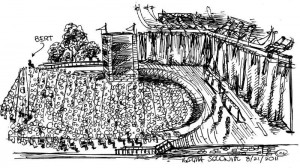
Those Lips, Those Eyes, United Artists, 1980, Cain Park amphitheater, Cleveland Heights. Bert Stratton at far left.
—-
A version of this story is crossposted today at CoolCleveland.com.
August 31, 2011 4 Comments
SEARCHING FOR GALICIA
My father, Toby, was a lot like his mother. One of Toby’s mother’s favorite expressions was “Geven-zhe nit a yold.” (Don’t you be a chump.) Toby’s mother owned a candy store, raised four kids almost singlehandedly, buried a three-year-old daughter, and during her retirement years, owned a four-suite apartment building. She was nobody’s sucker.
Anna Soltzberg (née Seiger) occasionally called her grandchildren — like me — foyl (lazy). She lived at our house for a while. I called her Bub — short for bubbe (grandmother). I wasn’t going to call her Bubby. Too effeminate.
Bub was not into baseball; she was into casino (a card game), the television show Queen for a Day; borscht, boiled chicken and cows’ feet. She could eat. She had sugar diabetes. Bub wore bubbe shoes.
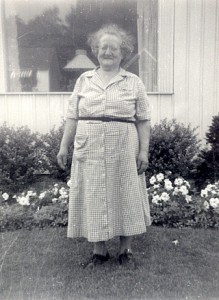
Anna Soltzberg (1884-1964). Circa 1951.
I couldn’t figure out where Bub was from. I couldn’t even find her hometown on a map.
Bub said she was from Galicia, a province in Austria-Hungary. She was from the shtetl (village) of Grodzisko. She came to America at 20.
In junior high I told my friends, “My grandmother is from Austria.” That was dead wrong, but it made sense.
In her old age, Bub lived at my aunt’s house before she moved in with us. At my aunt’s, Bub complained about the level of kashrut (kosher observance). Bub wanted my aunt to not keep kosher. Keeping kosher was too expensive. Bub was an apikoros (non-believer), socialist and cheap.
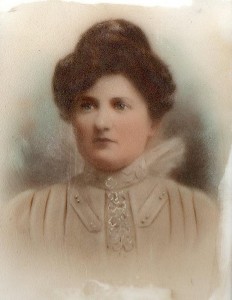
Bub, circa 1904.
At Bub’s funeral — at the shiva (mourning) meal — the question of kashrut came up again. My two aunt Lils (Lil from Delaware and Lil from Washington), plus my Uncle Itchy, were at our dining room table.
Uncle Itchy, sitting next to Delaware Lil, asked, “You keep a kosher house?”
“Yes,” said Delaware Lil.
Itchy, slapping his hand down on the table, said, “Then why are you eating this meat? It’s not kosher!”
Washington Lil, also slapping her hand down, said, “Ain’t that a hypocrite!”
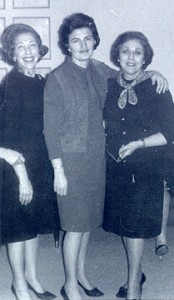
Washington Lil (left), Julia Stratton, Delaware Lil. 1964
“In other words, it’s either everything or nothing?” said Delaware Lil.
“Yes,” said Washington Lil.
“That’s a very simple philosophy,” said Delaware Lil.
“Yes, it is,” said Washington Lil.
My mother, Julia, interrupted with: “Pass the treyf meat.” (Non-kosher meat.) Mild laughter. My mom was the peace-maker.
And the Lils didn’t talk to each other for a long time. Years.
. . . Grodzisko, Galicia, Austria-Hungary. I found it about 20 years later, in the mid-1980s, on the Shtetl Finder map. The village’s Yiddish name was Grodzisk (pronounced GRUD-zhisk), about 60 miles west of Przemysl. The various shtetls (villages) had so many different names. That was the trick. And there were several Grodziskos.
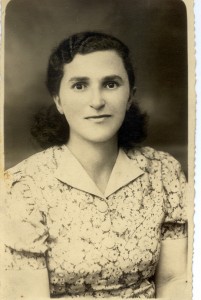
Mili Seiger 1939
During my research, I came across a family postcard, postmarked “May 1, 1939, Grodzisko.” It was from cousin Rachela Seiger. It was in Polish and said, in brief, “How are you?” On the flip side was a photo of Rachela’s sister Mili.
The Germans invaded Poland four months after the postcard was mailed.
I looked up “Mili Seiger” and “Rachela Seiger” on the Yad Vashem (Israeli Holocaust museum) online archives. There were so many Seigers, Siegers, Zygers, Zaygers and Zeigers, I couldn’t find Mili or Rachela.
There are three types of Jews. Not Reform, Conservative and Orthodox. Try American, Israeli and victims of the Holocaust. Each about a third. These are my people.
—-
This story was cross-posted on The Forward, online, last month.
Thanks to Yiddishist Lori Cahan-Simon for help on the expression “Geven-zhe nit a yold.”
Footnote . . . Plotting Grodzisko by Teddy Stratton, 1998:
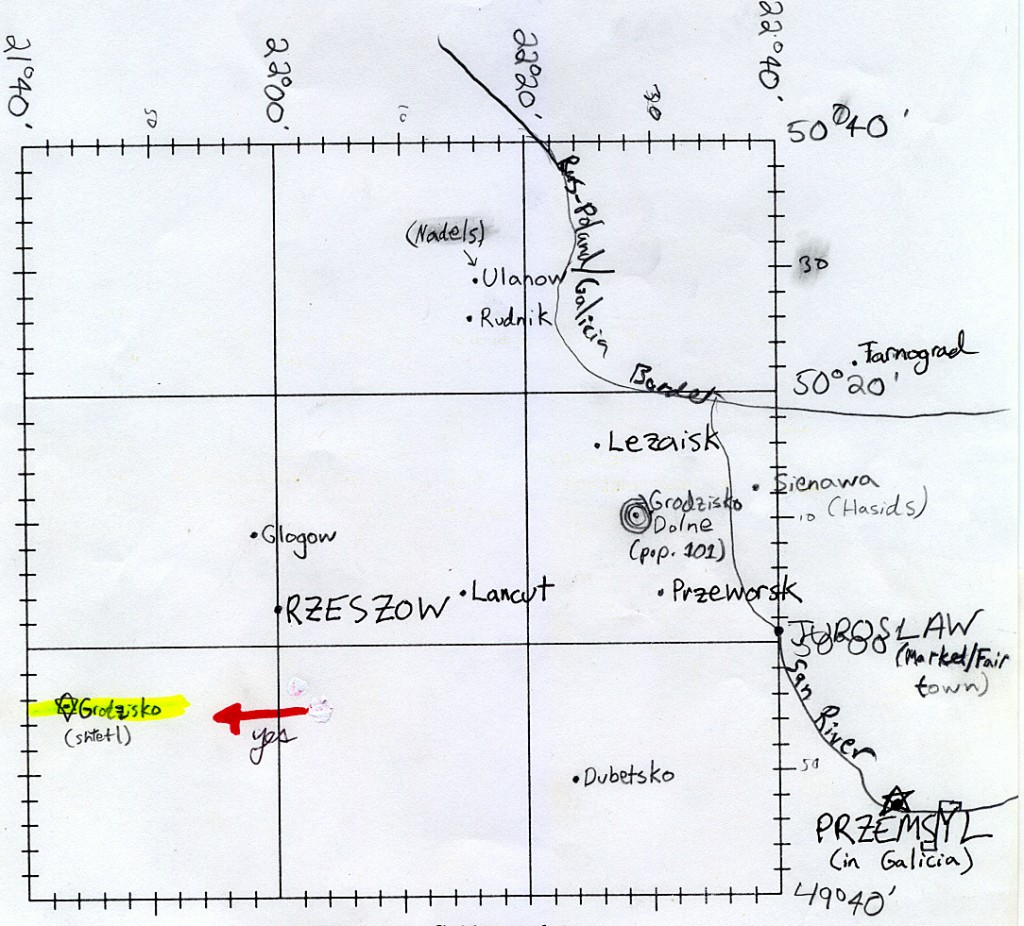
March 23, 2011 10 Comments
MAJOR ROOFER
I like roofs more than most people. I even married a roofer’s daughter.
My late father-in-law, Cecil Shustick, had a roofing company in Columbus, Ohio. He was an orthodontist prior to being a roofer. Look it up.
Cecil was an orthodontist in the early 1950s. Meanwhile, Cecil’s father owned a roofing company. Cecil had a wartime neck injury, so he didn’t relish standing all day at a dental chair. Furthermore, orthodontia wasn’t yet a big moneymaker in central Ohio.
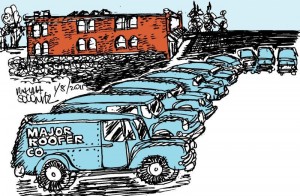 Cecil did mostly roof estimating. He eventually ran a 27-man, 9-truck company.
Cecil did mostly roof estimating. He eventually ran a 27-man, 9-truck company.
He talked to me about roofs and gutters. Gutters are interesting: copper, galvanized (the worst) and coated.
Cecil didn’t offer me the biz. He should have, my father said. My dad said Cecil should have at least given me the opportunity to say no.
Dad, I wasn’t moving to Cow-lumbus to run a roofing company!
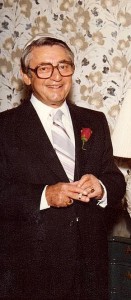
Cecil Shustick (w/ ciggy), 69. (1978)
When Cecil retired, he sold the business to Don The Goy, his right-hand man, who ran the biz into the ground. Cecil lost a lot of money on that, and so did I, indirectly.
If I had taken over the business, I probably would now be in a nice house in Bexley, Ohio, with a stack of workers’ comp claims in front of me. (A lot of roofers are overweight drinkers with back problems.)
That wouldn’t be much different than the way I did wind up!
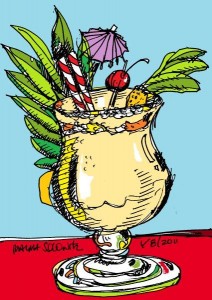 Cecil was a bon vivant. He kept a quart of piña colada by his bed for dry throat, due to antihistamine overuse, he said. He liked top-shelf, like Chrysler Imperials and Chivas Regal. And he didn’t like sweating. Golf was his game. Cecil said, “If man was meant for jogging, he’d have hooves.”
Cecil was a bon vivant. He kept a quart of piña colada by his bed for dry throat, due to antihistamine overuse, he said. He liked top-shelf, like Chrysler Imperials and Chivas Regal. And he didn’t like sweating. Golf was his game. Cecil said, “If man was meant for jogging, he’d have hooves.”
***
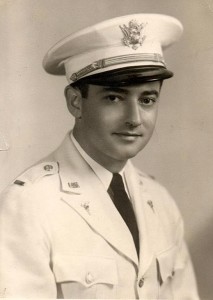
Cecil Shustick, U.S. Army Dental Corps, circa 1942
Cecil worked in roofing, went to war and raised a family. I didn’t know that “early Cecil.” I knew the retired Cecil, my father-in-law in the velour warm-up suit with the Marlboros.
Don Whitehead, an A.P. correspondent, filed a dispatch, Dec. 3, 1943, with the Fifth Army south of Rome:
In one large, roomy cave Capt. Cecil Shustick, Columbus, Ohio, and Lt. Samuel Clarkson, Lebanon, Ky., set up a medical detachment station. On the little ledge, a charcoal fire was burning to take the damp chill from the air . . .
The Italians had used the caves as storage places for vegetables, fruit and grain. When the Americans came along, they moved into them and used them as command posts, medical stations and billets.
This is a valley of hell – a man-made hell of thunder and lightning . . . The guns never cease their striking. Whole batteries of them roar in unison with a concussion that shakes the earth.
Cecil Shustick came home a major with a Bronze Star for heroism at the Battle of Monte Cassino, Italy.
Give him the piña colada medal too, posthumously. Cecil kept things light and bright. You’d never know about Italy.
—-
Please see the post below too. It’s fresh and it’s football.
—-
Yiddishe Cup plays the Boca Raton (Fla.) JCC Sun. Jan. 23. 3 p.m.
January 12, 2011 11 Comments
RETURN OF THE MAGGIES
Maggies were linoleum salesmen/hustlers in Cleveland.
Harvey Pekar wrote a comic strip about them several decades ago. I didn’t hear the word maggies again until last week, when my cousin Danny Seiger, 78, expounded at shabbes dinner on the maggies of Kinsman Road. At first I had no idea what Danny was talking about. Neither did my wife. She said, “Magistrates?” And I said, “Magi?” (I hadn’t remembered the Pekar comic strip.)
“Magi!” Danny laughed. “Magi? That would be Yoshke’s boys!” [Jesus’ boys.]
“The maggies carried thick samples of linoleum that looked like Venetian marble,” Danny said. “They sold nine-by-twelve sheets for fifteen dollars. Nobody had fifteen dollars back then, so the maggies took five bucks on installment, and came back with a roll of tissue-paper. They could carry it upstairs real easy. It weighed three pounds. The maggies laid the tissue-paper linoleum on your kitchen floor, collected the five bucks, and never came back.”
Danny grew up in his parents’ deli, Seiger’s Restaurant on Kinsman Road, and knew something about conmen, kibitzers, bookies, contractors and maggies. It was like an Eskimo knowing about snow. [Kibitzers are meddlesome observers.]
The maggies sold more than linoleum, Danny said. They sold ties at barbershops, socks at saloons. Each maggie had a territory and a product line. “One maggie stood by the streetcar stop and ran up to women with nice lemons,” Danny said. “The maggie held up a few lemons and said, ‘Two for a nickel, three for a dime.’ The woman gave him the dime and hopped on the streetcar.”
***
Relevant: Yiddishe Cup plays the Harvey Pekar (urn) Benefit this Saturday night at the Beachland Ballroom, Cleveland. If enough funds are raised, Harvey’s urn goes next to Eliot Ness’ grave at Lake View Cemetery.
I Googled “Maggies” after my cousin Danny left. Maggies, an Irish music group, popped up. Then I tried “Maggies + Pekar.” I was thinking about Pekar because of the Beachland gig, and something about “Maggies + Pekar” jogged my memory . . .
Michigan State University Libraries,
Comic Art Collection.
“The Maggies: Oral History”/story by Harvey Pekar;
art by R. Crumb. 2 p. in American Splendor, no. 7 (1982).
I phoned Danny Seiger and read the Pekar story to him. I wanted to know if Turk’s deli — where the maggies hung out in Harvey’s comic — was the same place as Seiger’s deli. Danny said, “Turk’s was at One-hundred Seventeenth. We were at One-hundred Eighteenth.”
I said, “There were two delis right next to each other? How many delis were there in Cleveland?”
“There were seven on Kinsman, and twenty-eight in Cleveland in the 1930s,” Danny said.
“What about Zulu Goldberg and his brothers — the guys in the comic who sold linoleum in bulk to the maggies?” I asked. “Was Zulu a real person?”
“That’s Goldbergs from Ohio Savings,” Danny said. “They did business.”
***
Maggies, the word, comes from Magnoleum, a linoleum brand, Danny said. Pekar’s comic-strip character — an unnamed old man — said maggies got their name from calling female customers Maggie.
Harold Ticktin, 83, a former Kinsman cowboy and street-corner historian, might be able to settle this.
Answer the phone, Harold!
. . . Harold says, “I have no idea what maggies are. Never heard of it. Now there was this Italian, Tom Black, who sold sweaters at One-hundred Forty-second and Kinsman. You tried the sweaters on in the bathroom at the gas station. The sweaters looked real good in front but went up your back like a window shade.”
—-
Yiddishe Cup plays 8-9 p.m. this Sat. (Aug. 7) at the Harvey Pekar (urn) Benefit at the Beachland Ballroom, Cleveland.
August 4, 2010 2 Comments
